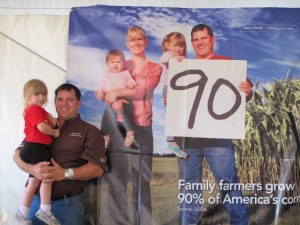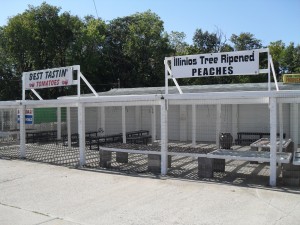Posted By Mark October 26, 2010
Building off a successful campaign conducted across Nebraska a year ago, Nebraska Corn Farmers have created a new series of messages that feature several Nebraska farm families sharing facts about how today’s corn farmers are more sustainable than ever.
 The Sustaining Innovation campaign echoes a promotional campaign conducted in Washington, D.C. by the Corn Farmers Coalition which is comprised of more than a dozen state corn organizations including Nebraska and the National Corn Growers Association.
The Sustaining Innovation campaign echoes a promotional campaign conducted in Washington, D.C. by the Corn Farmers Coalition which is comprised of more than a dozen state corn organizations including Nebraska and the National Corn Growers Association.
“We feel it is important to share positive messages about corn farming today to better help people understand just how far farmers have come in caring for the environment while producing a growing abundance of corn,” Curt Friesen, a farmer from Henderson who chairs the Nebraska Corn Board’s market development committee, said in a news release.
Some of the positive messages include the fact that American farmers have reduced the energy used to produce a bushel of corn by 37 percent over the past three decades and that farmers are producing more corn per ounce of fertilizer than just 35 years ago.
Importantly, the messages also highlight the fact that 95 percent of all corn farms in the nation are family owned.
“We’re excited to be part of this campaign because we believe family corn farmers have made significant advancements to grow more corn per acre while requiring fewer inputs per bushel to do so,” said Chris Flaming, who is featured in one of the ads with his wife, Korene, and children. The Flamings farm near Elsie, Nebraska.
“People need to understand that it’s real families making their livelihood raising corn and that we’re doing the right things because we want our children to have an opportunity to farm, too,” Chris Flaming said
You can read more information on this remarkable story here.
Posted By Mark October 25, 2010
 “You can fool some of the people all the time, and those are the ones you want to concentrate on.” George Bush
“You can fool some of the people all the time, and those are the ones you want to concentrate on.” George Bush
If you are a Bill Cosby fan you probably have fond memories of his show “Kids Say the Darndest Things.” I would suggest the networks might want to consider a new program entitled “Leaders and Captains of Industry Say the Darndest Thing.” And let’s start with oil executives who say the most amazing things including bashing any competitive technology that displaces their market share.
The petro industry is so entrenched and powerful they regularly make clarion call comments in public that are equal parts frustrating, comical and transparent. For example at a recent Oil & Gas Conference in Bakersfield, CA an oil industry high-roller complained about “unrealistic and unnecessary policies aimed at gradually weaning the nation of its dependence on oil and natural gas.”
The event’s keynote speaker, John Felmy, chief economist at the American Petroleum Institute, drove this point home by calling on attendees to spread the message that the Obama administration’s push for greater use of renewable energy, as well as its attempts to reduce subsidies to the industry, are disingenuous, delusional and dangerous.
If oil industry execs are making such comments in a public forum it makes me really want to be a mouse in the boardroom to hear the really good stuff. My guess is they would really like the unwashed masses to just send them their paychecks and shut-up.
Felmy not only criticized the push for greater use of biofuels but took issue with claims that electric vehicles represent a viable option to internal combustion engines. “For the lifetimes of everybody in this room, we’re going to be using oil. No doubt about it,” he said.
Now there is a man with an open mind and vision. All told the tax deductions, credits and other public benefits the oil industry receives, U.S. taxpayers support oil to the tune of between $133.2 billion and $280.8 billion annually. Considering the direct and indirect costs of our oil addiction I hope Mr. Felmy is wrong.
Ironically, American oil companies would likely benefit dramatically from President Obama’s clean energy agenda. They have the capital, the manufacturing capacity, and the engineering wherewithal to dominate the clean energy economy
In the mean time here is an Irish proverb for our leaders to contemplate”
“You never miss the water till the well has run dry.”
Posted By Mark October 13, 2010
 For years discovering how many perks, incentives and subsidies the global oil industry receives has been the Holy Grail of biofuels supporters. They are so numerous and come from so many places it is mind boggling, troubling and something akin to finding the Loch Ness monster. Thanks to Todd Neeley of DTN a hint of our true exposure is surfacing in part one of a new “must read” series.
For years discovering how many perks, incentives and subsidies the global oil industry receives has been the Holy Grail of biofuels supporters. They are so numerous and come from so many places it is mind boggling, troubling and something akin to finding the Loch Ness monster. Thanks to Todd Neeley of DTN a hint of our true exposure is surfacing in part one of a new “must read” series.
This is critical information because consumers should know what their addiction to imported petroleum is really costing them and Big Oil has never been shy about bashing incentives for the domestic ethanol industry, the only real competition they face in the marketplace. They try to be-little the contributions of family farmers and the American ethanol industry that now produce as much ethanol as what we currently import from Saudi Arabia.
At the end of the day you have to question why a century old industry like oil, whose major players consistently rank in the Fortune 100 companies, conservatively receive 10 times the incentives received by ethanol. As Neeley says, “Using the most liberal definition of public financial support, including tax breaks on equipment depreciation and foreign investments, oil’s total benefit from the public treasury can be as much as 10 times that of ethanol.”
DTN’s tally for state and federal tax incentives for oil comes to $17.9 billion annually. All told the tax deductions, credits and other public benefits the oil industry receives, U.S. taxpayers support oil to the tune of between $133.2 billion and $280.8 billion annually. “The comparable figure exclusively for ethanol is $7.1 billion. This does not include tax credits and other incentives that both industries share, such as the blenders’ credit or VEETC”…or the roughly $7 billion to $28 billion in military costs to protect oil supplies. Let’s not forget the White Elephant of lives lost either.
Interestingly, oil interests say they need the taxpayer largesse to do research and explore for more petroleum to continue our legacy of dependence. Makes you wonder what the impact would be if they invested the $200 billion oil says they spend on research in making ethanol more efficiently and from even more sources.
And as for oil exploration, I would rather invest my money in ethanol. . We know where farmers live and what their productive capabilities are when they are challenged to meet market demand. Eight record crops in the last eight years prove it.
Posted By Mark October 13, 2010
 Today’s guest blogger is Jeff Fowle a fourth generation family farmer and rancher from Etna, California. He also writes a blog called Common Sense Agriculture.
Today’s guest blogger is Jeff Fowle a fourth generation family farmer and rancher from Etna, California. He also writes a blog called Common Sense Agriculture.
I am writing in response to the opinion piece that was published in your Lifestyle section on October 11, 2010. It is sad that you would publish an article by an animal rights activist that paints every farm, ranch and animal facility with one broad brush of inaccuracy and fallacy. The vast majority of farmers and ranchers treat their animals humanely and respectfully. As a rancher and an active animal welfarist, I would like to share the following thoughts.
First, this is a personal issue for family farmers and ranchers like me. We consider our animals a part of our family and often spend more time caring for our animals than we spend with our families. We make sure our animals have the highest quality food, water and veterinary care; health is paramount. We also do our best to protect our animals from disease, competition, injury and predators.
Second, the writer makes it sound as though these practices are typical. Those of us involved in farming and ranching know that is not so. Without healthy, content animals, farmers and ranchers could not stay in business. We understand the importance of animal care in assuring safe and high-quality meat, milk and eggs for our communities. Some of us personally know our consumers, others do not, but we always make it a priority to ensure that the food we are raising is the best cared for and of the highest quality.
Third, farmers and ranchers are as disgusted as anyone by the abuse alleged in this opinion piece. If people are abusing animals, they should be prosecuted to the full extent of the law. One incident of mishandling is one too many. There must be zero tolerance for inhumane animal treatment, period.
There are a lot of dedicated people who specialize in animal care, people like veterinarians, animal scientists and experts on animal well-being. Farmers and ranchers have been actively working with them to create quality-assurance programs that set guidelines for animal handling to eliminate stress, decrease risk of injury (to both animal and human) and ensure the highest quality of animal products for American consumers.
In closing, as a family rancher, I thank you for the opportunity to respond as an individual who depends on ensuring the health and welfare of the livestock I raise to be able to continue to provide a high quality, safe, wholesome and nutritious product.
Farmers and ranchers across the United States are telling their stories through videos, blogging and photos. Consumers can connect with them to see how they care for their animals and raise the safest food possible at http://www.agchat.org. You can contact Jeff here.
Posted By Mark October 7, 2010
 Our dependence on foreign oil has a cost. It is an enormous cost and the drain on our nation’s economy creates all kinds of issues for our society that nobody wants to talk about. And the oil companies least of all.
Our dependence on foreign oil has a cost. It is an enormous cost and the drain on our nation’s economy creates all kinds of issues for our society that nobody wants to talk about. And the oil companies least of all.
Big oil spends millions annually attempting to give alternative sources of energy a black eye, while some few in that industry see benefits and are investing in things like ethanol production. But most are avoiding engaging in a real dialogue regarding consumer’s future fuel needs, growing environmental concerns, and our national security.
It’s not really a stretch to find a motivation considering the enormous profits these multi-national oil giants have squeezed from Americans as a result of their absolute control of the market. Former CIA Director R. James Woolsey has been a big ethanol supporter for one primary reason - it diverts dollars to US energy producers otherwise being sent to the Middle East for imported oil.
He says $3-4 billion of the $160 billion we send the Saudi’s every year ends up with the “bad guys.” We subsidize our enemies with every barrel of oil that we import.
We now appear to be days away from an announcement by the Environmental Protection Agency regarding the approval of up to E15 (15% ethanol mixed with gasoline) in our cars. The blend has been thoroughly tested for motor vehicles yet the anti ethanol forces such as big oil and some curious minions like the Grocery Manufacturers Association (the cheap corn fan club) are asking people to write President Obama asking him to stop impending EPA approval of E15.
Groups such as FollowtheScience and Energy Citizens are really nothing but fronts for organizations like National Petrochemical & Refiners Association and the American Petroleum Institute.
Large numbers of Americans strongly supports the EPA’s approval of E-15 for motor vehicles mainly based on their positive experiences with E10. EPA has the information it needs to act. So if you want to counteract the naysayers email the president and tell him “yes, for tested and proven E15.” Or call the White House at 202-456-1414.
U.S. ethanol production currently eliminates the need for 98.6% of Venezuelan crude oil imports, or 95.7% of crude oil imports from Saudi Arabia. It is representative of 55.6% of total Persian Gulf crude oil imports. I’d say the ethanol industry has provided a good start to negating the National Security risks associated with our dependence on foreign oil.
Posted By Guest Blogger October 6, 2010

This guest blog comes compliments of Darin’s Ramblings and farmer Darin Grimm.
Please note this is a rant, I hope it doesn’t detract from the quality I want to bring to this blog, but it’s my thoughts this morning, so I’ll share.
I’m tired of seeing the constant bashing that corn gets in social media or even pop culture today. I grow corn, and I’d like to try to explain a bit why I do.
You see, each year, I make choices of what I wish to plant. The freedom is mine, as someone trying to make their living off the land, I tend to be interested in crops that might generate the income I need to raise my family. I could plant papayas, lilacs, or even green beans, but I don’t. Unfortunately, the Kansas weather is what it is, and there’s folks around the world that can raise those things much better/more affordably than I can. We can raise corn here though, because we can (at least most years).
I hear how subsidized corn is.. I wish folks could understand, looking back on the last three years of financials on our farm, we have received some subsidies, I would love to debate that issue some day, like most centrally planned government programs, the farm bill that delivers those subsidies leaves a lot to be desired, but that’s not the point of this post.. The point is, I could have grown pretty much whatever crops I wanted the last few years, and my subsidy check from the government would have been EXACTLY the same. My farm received no subsidies for planting corn instead of another crop.
I hear all the time from the environmental crowd how destructive corn is there. Well, probably THE most important environmental resource on our farm is the soil. I’d invite anyone to come visit, esp. after a heavy rain, bring your mud boats, we can walk some fields and I can show you the tremendous soil conservation benefits of corn residue vs. other crops. Not only does it keep the soil from washing/blowing, but the massive residue provides the building blocks for improving organic matter, a key component of soil health.
Having said all that, let me say this. I’d love to find another crop to grow. Preferably one that let us spread the workload out a bit, gave us more to do say in the summer, and help alleviate the stress of trying to do everything in the spring/fall. I actually hoped wheat could fill that role, unfortunately there’s less and less wheat being planted in northeast Kansas. If you think that’s because somehow that “massive corn lobby” has swindled a bunch of Kansas farm folk into planting a crop we don’t want to… Uugg, thanks for having so much confidence in us, but please read this post again.
For those that have the perfect “system” of how to change all this, so I can grow papayas, lilacs, green beans, or whatever your wonder crop is, lets have that discussion.. here in the comments, Twitter, Google Buzz, wherever you prefer. But I’ll tell you my bias going in.. Markets bring excesses, they swing too far at times, but I’m pretty confident this thing called the market does a pretty good job of telling me if and when I should be growing corn.
Posted By Mark October 5, 2010
 Remember when social media was the shared black & white TV at the coffee shop? Whatever happened to college kids avoiding extra work? Since when did young farmers become social activists, bloggers, and even models for national advertising campaigns? It’s a brave new world and it couldn’t come too soon.
Remember when social media was the shared black & white TV at the coffee shop? Whatever happened to college kids avoiding extra work? Since when did young farmers become social activists, bloggers, and even models for national advertising campaigns? It’s a brave new world and it couldn’t come too soon.
Don’t get me wrong, I have spent much of my adult life working with and for farmers, and they make unbelievable sacrifices. Managing large and complex businesses and constantly improving farming techniques, raising families, and most are pillars of their local communities. Church board meetings, school board meetings, and even volunteer fire department gatherings might well be a Farm Bureau meeting or a Corn Grower conclave.
But what is happening today is almost revolutionary. Once content to take care of business in their own backyard, today’s rural youth and young farmers seek to carry on the aforementioned legacy of civic responsibility but they are also stepping up to become citizens of the world.
Modern communications have helped to assure city limits are largely arbitrary. Your “community” is limited only by your imagination. Social media tools like Facebook, Twitter and You Tube have kicked open the door to the world, and timing couldn’t be better.
Consumers have never been so removed from (and in some cases afraid of) their food supply and this window to the world provided by social media allows people to look into your life and vice-a-versa. Dialogue ensues and with it, hopefully, better understanding and rapport.
Success stories about those who have made the leap (see blogger link above) are getting more common and as a result these once lone voices are amplified. I came across a perfect example today. College student Kelly Rivard (@kmrivard on Twitter) pursued an internship with a commodity group to help her efforts to eventually land a job in Ag communications. The internship included starting a blog. The internship ended but the blog is alive and well.
Recently it was picked up by a Fox affiliate that services people in much of Central Illinois, including four large cities. Because it is web-based the audience is really unlimited. Blogs by these 20-something college students and YouTube videos by FFA’ers with flip cams are capturing their love for one of our most critical industries and sharing it with the masses.
Another good example is Kurt Hora shown in the accompanying photo. This young farmer from Iowa grows corn and soybeans, raises hogs and has a young family to fill his days. Lots of responsibility, and yet he took time to be a part of the Corn Farmers Coalition project this year in order to put a face on family farmers, to give his fellow farmers a voice, to spread key messages consumers need to know.
Examples abound. A new generation of voices is speaking out for agriculture and they are using every tool and opportunity available. This bodes well for the future. If you would like to know more check out Seven Secrets to Successful Social Media Farming.
Posted By Mark September 27, 2010
So what wine goes best with myths and lies? Apparently someone better figure this out quickly as the American public is getting served up a lot of misleading information and in some cases out right fabrications regarding what they eat. The latest list of food fibs and myths come from the Editors of Eating Healthy Magazine who expose a number of urban food myths including the demonization of High Fructose Corn Syrup (HFCS).
In short, it (HFCS) seems to be no worse—but also no better—than sucrose, or table sugar. “The debate about HFCS and sucrose [table sugar] is taking the focus off the more important question,” says Kimber Stanhope, Ph.D., R.D., a researcher at the University of California, Davis, who has studied the sweetener extensively. “What we should be asking is ‘What are the effects of all sugars (HFCS and sucrose) in the diet?’”
It is interesting to note that High Fructose Corn Syrup (HFCS) is number two on the list of the 13 biggest nutrition and food myths put together by Joyce Hendley, longtime contributing editor at the magazine.
Myth 2: High-Fructose Corn Syrup (HFCS) is worse for you than sugar.
The Truth: The idea that high-fructose corn syrup is any more harmful to your health than sugar is “one of those urban myths that sounds right but is basically wrong,” according to the Center for Science in the Public Interest, a health advocacy group.
The composition of high-fructose corn syrup is almost identical to table sugar or sucrose (55 percent fructose, 45 percent glucose and 50:50, respectively). Calorie-wise, HFCS is a dead ringer for sucrose. Studies show that HFCS and sucrose have very similar effects on blood levels of insulin, glucose, triglycerides and satiety hormones. In short, it seems to be no worse—but also no better—than sucrose, or table sugar.
This controversy, say researchers, is distracting us from the more important issue: we’re eating too much of all sorts of sugars, from HFCS and sucrose to honey and molasses. The American Heart Association recently recommended that women consume no more than 100 calories a day in added sugars [6 teaspoons]; men, 150 calories [9 teaspoons].
The Yahoo-based internet community called Shine takes the Healthy Living list and boils it down to their “six biggest lies” about food and HFCS remains near the top.
The silliness of the HFCS issue is providing some good fodder for hawkers of humor such as Jim Borgman and Jerry Scott, the co-creators of the Zits comic strip. You have to marvel at their ability to send a strong message with a little over 40 words, but in this case one will do - “moderation.”

Posted By Mark September 24, 2010

 Let me say right up front that I love the idea of local farmers markets. I am actually fortunate to live in the rural Midwest where we have conventional farmers markets and many farmers put signs by their lane offering sweet corn and other produce from their (large) gardens.
Let me say right up front that I love the idea of local farmers markets. I am actually fortunate to live in the rural Midwest where we have conventional farmers markets and many farmers put signs by their lane offering sweet corn and other produce from their (large) gardens.
It doesn’t get any better than driving up to a farmer’s doorstep and loading up the trunk. But for those that don’t get outside the city farmers markets offer the same attraction. Produce is cheaper, fresher and often tastier because it is picked at peak ripeness. And whether at the farm or the market there is the bonus of visiting with the grower which is generally fun.
But here is the rub; October looms around the corner and with it the closure of many farmers markets for the season. Given the large harvest moon hanging in the sky this week it also means what you find at these markets is changing. Tomatoes and cucumbers are rapidly being replaced by squash and pumpkins and empty shelves or parking lots will soon follow where abundance ruled in the summer months.
So while there is a certain attraction to being a locavore, culinary adventurer’s who attempt to survive on food grown and harvested within a 100 mile radius, the prospects are a bit grim if you don’t live in California, Florida or similar Sunbelt locales. (Although there appears to be some honesty issues in some markets even in Sun Country where farmers market vendors are passing off produce from the same wholesalers used by grocery stores as locally grown.)
As you can see in the attached photo many markets have already closed for the season and two months from now these market locations will be clutched in the frosty grip of a Midwestern winter.
Of course there is always the labor intensive option of preserving food for the winter months, but personally, I like having the freedom offered by modern conveniences like grocery stores. I have no desire to go back to canning like Michael Pollan’s grandmother or crawling into a root cellar in February for the pitiful offerings they used to produce.
I think there is tremendous opportunity for growth for locally grown food and we should encourage schools and restaurants to serve local food and even establish more community gardens. Especially if it helps us recognize that the choices we make about what foods we choose to eat are important politically, environmentally, economically, and healthfully.
But I for one will continue to approach this subject with a skeptical eye, especially regarding those who think it’s either locally grown or conventional agriculture rather than both in concert.
Posted By Mark August 16, 2010
 People for the Ethical Treatment of Animals has long been notorious for singleness of purpose but more so for many of its outlandish publicity stunts. Many of these inane stunts have gone a long way to hurt their credibility.
People for the Ethical Treatment of Animals has long been notorious for singleness of purpose but more so for many of its outlandish publicity stunts. Many of these inane stunts have gone a long way to hurt their credibility.
However, despite some of these goofy antics, many individuals and companies have given in to their demands rather than face any bad press. So it was refreshing to see their latest potshot at Dodge did a huge belly flop.
Dodge recently found itself in PETA’s crosshairs after the carmaker aired a commercial starring a monkey dressed up like Evel Knievel. PETA screamed monkey abuse and demanded the commercial be pulled. But, unlike many who draw the ire of PETA, Dodge fought back in a most amusing way.
Enter the invisible monkey and a new creative and comical way to deal with our animal rights brethren who are wound a bit too tight.
 The Sustaining Innovation campaign echoes a promotional campaign conducted in Washington, D.C. by the Corn Farmers Coalition which is comprised of more than a dozen state corn organizations including Nebraska and the National Corn Growers Association.
The Sustaining Innovation campaign echoes a promotional campaign conducted in Washington, D.C. by the Corn Farmers Coalition which is comprised of more than a dozen state corn organizations including Nebraska and the National Corn Growers Association.








